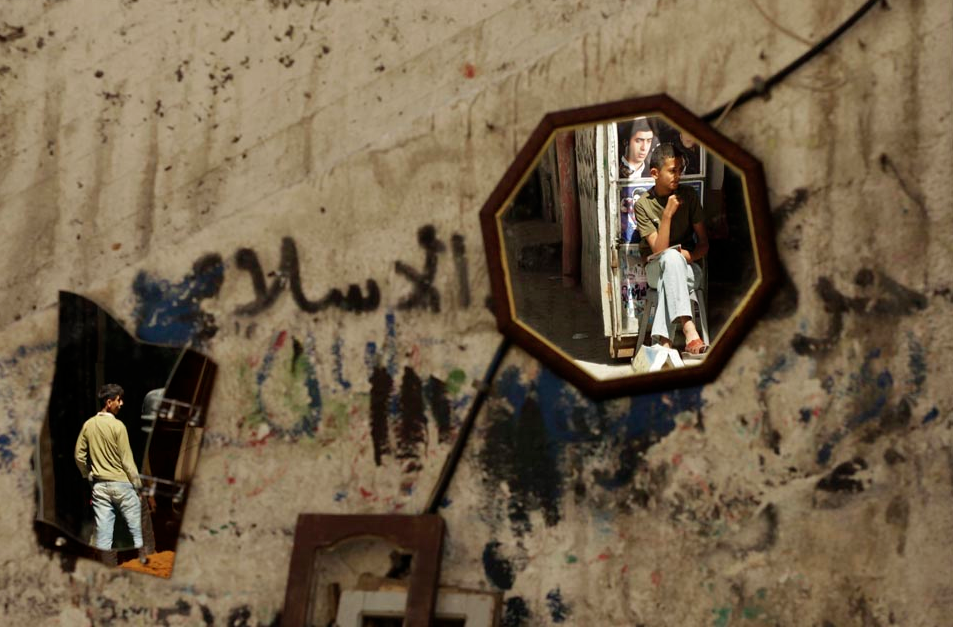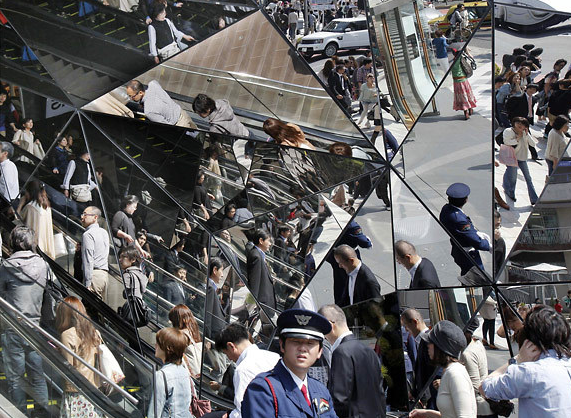The camera, we say, shows us the world it is pointed at. A mechanical representation of the world, it nevertheless presumes a degree of agency in the assumption that the camera lens fragments and frames the world, and someone has done the pointing. In this sense, it is an art. The mirror, however, presumes an enhanced degree of objectivity and a relative degree of passivity inasmuch as it literally reflects back everything within its purview. Lacking any obvious agency it is assumed to be fundamentally inartistic and thus arguably more “authentic.” Or at least that’s one theory of the relationship between the gazes of the camera’s lens and the mirror. But what happens when we photograph the mirror’s gaze?
Photographs of the mirror’s gaze are not uncommon and they are offer provocative examples of what W.J.T. Mitchell calls “showing seeing,” a pedagogical strategy for challenging the boundaries between nature and art, or what we might call the “real” and the “image.” The two photographs below are a case in point.
This first image is of Palestinians “reflected in mirrors as they sat outside a store in Gaza City.”
The mirrors have been affixed to a wall, one set within an octagonal frame, the other a simple shard of glass. Importantly, they are triangulated and connected to one another by what appears to be a broken picture frame, its matted image slipping out of sight. The difference between mirror and photograph are thus accented; mirrors can be framed, just like photographs, but even when the mirror’s frame is broken or missing, as with the shard of glass, it continues to relentlessly reflect its gaze back to the viewer. But even as the difference is underscored it is effaced, for what the photograph we are looking at shows is how the mirror is a medium for representing social relationality, framed by its very placement on a wall in a public place. Put differently, mirrors—like photographs—are an artifice by which we take account of our self presentation to the world, and that abides whether the mirror is mounted in our private hallway or in the agora of public relations.
The point is made somewhat differently in this second image of people “reflected at a shopping center in downtown Tokyo.”
Here, the photograph displays the mirrors reflections of a shopping center as a fragmented panorama of people coming and going in every which way. Because the glass is cut in a variety of geometric forms that are then welded together at odd different angles, the reflection is simultaneously real and imaginary. Each fragment (or shard?) is accurate in its representation, but the articulation of those fragments leaves us with a scene that is chaotic if not altogether incoherent. And so, once again, the viewer is confronted with the artificial—and hence artistic—representation of the mirror’s gaze. And once again, the very public location of the mirrors puts us in position to take account of ourselves as social beings.
That social self in these two images seems to be very different, and there is no doubt that that difference bears careful consideration. But the bigger point here is how these photographs of the mirror’s gaze remind us of the similarities between cameras and mirrors and the ways in which they function as artistic, reflexive spaces for monitoring ourselves, whether in private or in public.
Photo Credits: Mohammed Salem/Reuters; Koji Sashahara/AP


Fantastic images. The one with the two mirrors makes me wonder how those to people are connected in front of the mirrors. Do they know each other? Are they friends or enemies? Or have they never even seen each other. The second image is especially impressive because I can’t see the photographer in the mirror. That’s some good framing. This is one that I would love to see moving because the whole scene would be moving in every direction and adding to the chaotic feel of a shopping center.
Robbin: There is always more to say and you put your finger on what for me was an interesting aspect of the photos that I only (too vaguely) gestured to. The mirror is supposed to show everything in front of it. But that’s a bit of misdirection. Angles matter too. So in the first image its obvious that the two are in close to proximity to one another, but its impossible to know what that proximity is and even if, as you say, they are aware of one another. So we see our “selves” here in a way, perhaps that we experience the public sphere itself — a world of strangers. And so too the second photo in which the angles are so multiple and complex that in the end, as you say, its impossible to find the photographer in the image. And your point about the movement is equally apt. And it too speaks to the ways in which we do (and don’t) monitor ourselves. Thanks for the comment.
In your post you mention the agora, and in your comment you make reference to the public seeing itself. I came across another reference to the agora today, but here the author (David Graeber) compares the Athenian agora with a more ‘Roman’ way of the public seeing itself, namely, through the violence and choas of the circus. Much unlike the Athenian agora, the Roman circus featured unruly mobs and a general abandonment of dignity. Graeber calls the Roman circus an ‘ugly mirror phenomenon,’ where the unruly public sees itself, much to the approval of state authorities, as unfit to rule.
In the second photo we also see ourselves as a disjointed and fragmented public, lacking cohesion, fluidity, and so on. Interesting to note the figure in uniform looking back at us, as if in approval of the whole unruliness of it all.
Philip: Thanks for the great comment. Do you have the citation or a link for the reference to David Graeber?
These comments come from an essay by Graeber entitled “There Never Was a West: Or, Democracy Emerges From the Spaces In Between,” in Possibilities: Essays on Hierarchy, Rebellion, and Desire (Oakland, CA: AK Press, 2007): 329-374. (p. 343 in particular).